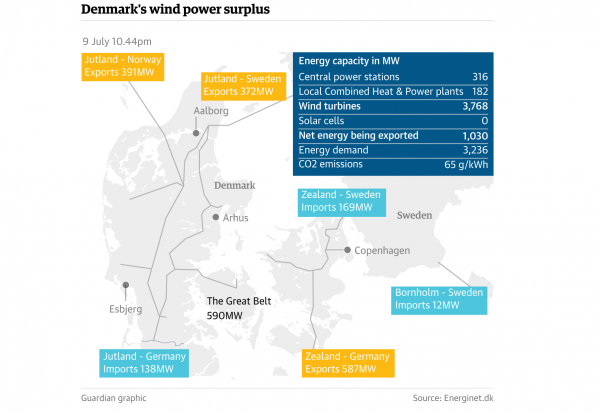So much power was produced by Denmark’s wind farms on Thursday that the country was able to meet its domestic electricity demand and export power to Norway, Germany and Sweden. On an unusually windy day, Denmark found itself producing 116% of its national electricity needs from wind turbines yesterday evening. By 3 AM on Friday, when electricity demand dropped, that figure had risen to 140%. Interconnectors allowed 80% of the power surplus to be shared equally between Germany and Norway, which can store it in hydropower systems for use later. Sweden took the remaining fifth of excess power.

“It shows that a world powered 100% by renewable energy is no fantasy,” said Oliver Joy, a spokesman for trade body the European Wind Energy Association. “Wind energy and renewables can be a solution to decarbonization – and also security of supply at times of high demand.” The figures emerged on the website of the Danish transmission system operator, which provides a minute by minute account of renewable power in the national grid. The site shows that Denmark’s wind farms were not even operating at their full 4.8GW capacity at the time of the peak.

A surge in wind farm installation means Denmark could be producing half of its electricity from renewable sources well before a target date of 2020, according to Kees van der Leun, the chief commercial officer of the Ecofys energy consultancy. “They have a strong new builds program with a net gain of 0.5GW in new onshore wind farms do before the end of the decade,” he said. “Some 1.5GW from new offshore wind farms will also be built, more than doubling the present capacity. Were seeing a year on year 18% growth in wind electricity, so there really is a lot of momentum.”
The British wind industry may view the Danish achievement with envy, after David Cameron’s government announced a withdrawal of support for onshore wind farms from next year, and planning obstacles for onshore wind builds. Joyce said, “If we want to see this happening on a European scale, it is essential that we upgrade the continents aging grid infrastructure, ensure the country’s open up borders, increase interconnection and trade electricity on a single market.” Around three quarters of Denmark’s wind capacity comes from onshore wind farms, which have strong government backing. ~The Guardian
